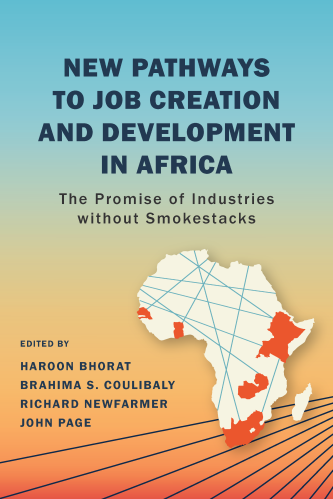In “New Pathways to Job Creation and Development in Africa: The Promise of Industries without Smokestacks,” experts from the Brookings Africa Growth Initiative and across Africa document prospects for large-scale job creation and structural transformation through more than just manufacturing.
Esther Lee Rosen sat down with one of the editors, Vice President and Director Brahima S. Coulibaly, to discuss some of the book’s key findings.
Esther Lee Rosen (ELR): Congratulations on the successful publication of your new book, “New Pathways to Job Creation and Development in Africa: The Promise of Industries without Smokestacks,” co-edited by you and Haroon Bhorat, Richard S. Newfarmer, and John Page!
The issue of creating productive jobs for the growing labor force in Africa through sectors outside of manufacturing has been a research focus for the Brookings Africa Growth Initiative. What has been the impetus behind this focus—and why has the traditional industrial sector not been as dynamic in the region as it has been in other regions such as Asia?
Brahima S. Coulibaly (BSC): Our book marks the culmination of several years of research and collaboration with think tank partners across Africa, motivated by the recognition that the continent’s structural transformation is unfolding very differently than in other regions. Historically, industrialization—particularly manufacturing—was the primary driver of mass employment and rising incomes, as seen in East Asia starting in the 1960s. Today, however, many developing countries are experiencing a global phenomenon dubbed “premature industrialization,” reaching manufacturing employment peaks earlier in their development journey and at much lower income levels, due in part to globalization and the increasing reliance on capital (i.e., less so on labor) in production. This trend has raised real doubts about whether the traditional model of development remains viable for Africa. Unlike the conventional development path of shifting labor from agriculture to manufacturing, industry and then to services, Africa’s shift away from subsistence farming has relied less on manufacturing and increasingly on sectors such as horticulture, higher-value agriculture, agro-processing, tourism, business services, and information communications technology (ICT). These modern sectors—which we call “industries without smokestacks”—are becoming new engines of growth, employment, and productivity. Beyond job creation for Africa’s burgeoning young population, our research explores a central question of how countries can foster development in a world where the old model no longer applies. This book is not just about productive jobs but also about rethinking the entire development model itself.
ELR: What are some ways in which the region can create productive jobs for its large and growing youth population through “industries without smokestacks” and, as outlined in the book, achieve structural transformation?
BSC: As we highlight in “New Pathways,” industries without smokestacks are sectors that share many of the growth-enhancing characteristics of manufacturing but operate in different spaces. These include tourism, business services, agro-processing, horticulture, ICT, and modern transport and logistics. Much like manufacturing, these industries are tradable across borders, rely on workers with moderate skill levels, demonstrate higher than average productivity, and provide opportunities for both technological upgrading and economies of scale. Importantly, they also have the ability to absorb large numbers of workers—a critical factor for countries with rapidly growing youth populations. In fact, their average employment elasticity is estimated at 0.9, meaning that each percentage point of growth in these sectors tends to generate more jobs than growth in other parts of the economy, including manufacturing.
Our research shows how this potential is playing out across Africa. Tourism, for example, contributes at least 3% of sub-Saharan Africa’s GDP and is even more significant in countries like Tanzania, where it accounts for roughly 14% of GDP and 3.2% of total employment. In Ethiopia, travel and tourism represent more than 11% of GDP and nearly 10% of jobs. Agribusiness also plays an outsized role: Kenya’s cut-flower industry alone employs between 40,000 and 70,000 workers, while Ethiopia’s flower exports generate more than 180,000 jobs. In South Africa, fruit packing supports around 300,000 workers. These cases illustrate how industries without smokestacks are already acting as engines of growth and job creation—and why they represent a powerful pathway for structural transformation in the region.
ELR: In the book, representatives of our regional think tank partners provided important insights and recommendations. What were some key takeaways that are important for policymakers in the region to consider?
BSC: Industries without smokestacks have enormous potential but realizing its potential requires deliberate policy action. The foundations for success in these new, modern sectors are not so different from those that support traditional manufacturing. Reliable electricity, efficient transport systems, and strong digital connectivity remain essential. While some of these industries may require lower upfront infrastructure spending, governments cannot sidestep investments in core infrastructure if they want to unlock broad-based growth. This means prioritizing reliable power and internet access, strengthening transport and logistics, building skills training programs aligned with market needs, and fostering regulatory frameworks that encourage competition and innovation.
Another key takeaway relates to skills. Industries without smokestacks tend to demand a higher share of skilled workers compared to traditional manufacturing. At the same time, there is room for both low- and high-skill job creation across different sectors. Agro-processing, export agriculture, horticulture, transport, and construction offer significant opportunities for lower-skilled workers, while tourism, ICT, and financial services are better positioned to absorb higher-skilled labor. For policymakers, the implication is clear: Investing in education and training must go hand in hand with sectoral strategies to ensure Africa’s young population is equipped to take advantage of emerging opportunities.
ELR: For those who are interested in delving deeper into this topic, what are some key resources you would recommend?
BSC: There are three key resources I would recommend. The first is Dani Rodrik’s seminal paper on premature deindustrialization, which frames the economic and political consequences of the observed deindustrialization trend. The second resource is a collaboration between Brookings and UNU-WIDER researchers focused on industrialization trends in Africa. Finally, I highly recommend watching the book launch event Brookings hosted, which brought together several experts and practitioners from the African continent and beyond to discuss the implications of the book’s findings as it relates to the development challenges of today.
The Brookings Institution is committed to quality, independence, and impact.
We are supported by a diverse array of funders. In line with our values and policies, each Brookings publication represents the sole views of its author(s).







Commentary
The future of industry in Africa: A Q&A with Brahima S. Coulibaly
August 22, 2025